Allosteric communication in class A β-lactamases occurs via cooperative coupling of loop dynamics
- PMID: 33755013
- PMCID: PMC8060031
- DOI: 10.7554/eLife.66567
Allosteric communication in class A β-lactamases occurs via cooperative coupling of loop dynamics
Abstract
Understanding allostery in enzymes and tools to identify it offer promising alternative strategies to inhibitor development. Through a combination of equilibrium and nonequilibrium molecular dynamics simulations, we identify allosteric effects and communication pathways in two prototypical class A β-lactamases, TEM-1 and KPC-2, which are important determinants of antibiotic resistance. The nonequilibrium simulations reveal pathways of communication operating over distances of 30 Å or more. Propagation of the signal occurs through cooperative coupling of loop dynamics. Notably, 50% or more of clinically relevant amino acid substitutions map onto the identified signal transduction pathways. This suggests that clinically important variation may affect, or be driven by, differences in allosteric behavior, providing a mechanism by which amino acid substitutions may affect the relationship between spectrum of activity, catalytic turnover, and potential allosteric behavior in this clinically important enzyme family. Simulations of the type presented here will help in identifying and analyzing such differences.
Keywords: KPC-2; TEM-1; medicine; molecular biophysics; structural biology; β-lactamase.
Plain language summary
Antibiotics are crucial drugs for treating and preventing bacterial infections, but some bacteria are evolving ways to resist their effects. This ‘antibiotic resistance’ threatens lives and livelihoods worldwide. β-lactam antibiotics, like penicillin, are some of the most commonly used, but some bacteria can now make enzymes called β-lactamases, which destroy these antibiotics. Dozens of different types of β-lactamases now exist, each with different properties. Two of the most medically important are TEM-1 and KPC-2. One way to counteract β-lactamases is with drugs called inhibitors that stop the activity of these enzymes. The approved β-lactamase inhibitors work by blocking the part of the enzyme that binds and destroys antibiotics, known as the 'active site'. The β-lactamases have evolved, some of which have the ability to resist the effects of known inhibitors. It is possible that targeting parts of β-lactamases far from the active site, known as 'allosteric sites', might get around these new bacterial defences. A molecule that binds to an allosteric site might alter the enzyme's shape, or restrict its movement, making it unable to do its job. Galdadas, Qu et al. used simulations to understand how molecules binding at allosteric sites affect enzyme movement. The experiments examined the structures of both TEM-1 and KPC-2, looking at how their shapes changed as molecules were removed from the allosteric site. This revealed how the allosteric sites and the active site are linked together. When molecules were taken out of the allosteric sites, they triggered ripples of shape change that travelled via loop-like structures across the surface of the enzyme. These loops contain over half of the known differences between the different types of β-lactamases, suggesting mutations here may be responsible for changing which antibiotics each enzyme can destroy. In other words, changes in the 'ripples' may be related to the ability of the enzymes to resist particular antibiotics. Understanding how changes in one part of a β-lactamase enzyme reach the active site could help in the design of new inhibitors. It might also help to explain how β-lactamases evolve new properties. Further work could show why different enzymes are more or less active against different antibiotics.
© 2021, Galdadas et al.
Conflict of interest statement
IG, SQ, AO, EO, AM, MM, CT, FG, JS, RB, AM, SH No competing interests declared, PA Pratul K Agarwal is the founder and owner of Arium BioLabs LLC.
Figures



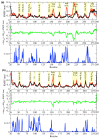


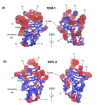
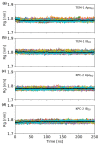
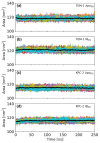
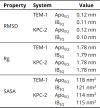

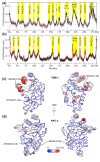








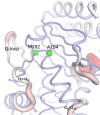
Similar articles
-
Klebsiella pneumoniae Carbapenemase-2 (KPC-2), Substitutions at Ambler Position Asp179, and Resistance to Ceftazidime-Avibactam: Unique Antibiotic-Resistant Phenotypes Emerge from β-Lactamase Protein Engineering.mBio. 2017 Oct 31;8(5):e00528-17. doi: 10.1128/mBio.00528-17. mBio. 2017. PMID: 29089425 Free PMC article.
-
Understanding the molecular determinants of substrate and inhibitor specificities in the Carbapenemase KPC-2: exploring the roles of Arg220 and Glu276.Antimicrob Agents Chemother. 2012 Aug;56(8):4428-38. doi: 10.1128/AAC.05769-11. Epub 2012 Jun 11. Antimicrob Agents Chemother. 2012. PMID: 22687511 Free PMC article.
-
The Role of the Ω-Loop in Regulation of the Catalytic Activity of TEM-Type β-Lactamases.Biomolecules. 2019 Dec 11;9(12):854. doi: 10.3390/biom9120854. Biomolecules. 2019. PMID: 31835662 Free PMC article. Review.
-
Communication between the active site and the allosteric site in class A beta-lactamases.Comput Biol Chem. 2013 Apr;43:1-10. doi: 10.1016/j.compbiolchem.2012.12.002. Epub 2012 Dec 12. Comput Biol Chem. 2013. PMID: 23314151
-
Structural and Mechanistic Basis for Extended-Spectrum Drug-Resistance Mutations in Altering the Specificity of TEM, CTX-M, and KPC β-lactamases.Front Mol Biosci. 2018 Feb 23;5:16. doi: 10.3389/fmolb.2018.00016. eCollection 2018. Front Mol Biosci. 2018. PMID: 29527530 Free PMC article. Review.
Cited by
-
The nuclear receptor LRH-1 discriminates between ligands using distinct allosteric signaling circuits.Protein Sci. 2023 Oct;32(10):e4754. doi: 10.1002/pro.4754. Protein Sci. 2023. PMID: 37572334 Free PMC article.
-
Loop dynamics and the evolution of enzyme activity.Nat Rev Chem. 2023 Aug;7(8):536-547. doi: 10.1038/s41570-023-00495-w. Epub 2023 May 24. Nat Rev Chem. 2023. PMID: 37225920 Review.
-
Activation mechanism of Drosophila cryptochrome through an allosteric switch.Sci Adv. 2021 Jun 18;7(25):eabg3815. doi: 10.1126/sciadv.abg3815. Print 2021 Jun. Sci Adv. 2021. PMID: 34144991 Free PMC article.
-
Multilevel superposition for deciphering the conformational variability of protein ensembles.Brief Bioinform. 2024 Mar 27;25(3):bbae137. doi: 10.1093/bib/bbae137. Brief Bioinform. 2024. PMID: 38557679 Free PMC article.
-
Deciphering the Coevolutionary Dynamics of L2 β-Lactamases via Deep Learning.J Chem Inf Model. 2024 May 13;64(9):3706-3717. doi: 10.1021/acs.jcim.4c00189. Epub 2024 Apr 30. J Chem Inf Model. 2024. PMID: 38687957 Free PMC article.
References
-
- Abraham MJ, Murtola T, Schulz R, Páll S, Smith JC, Hess B, Lindahl E. GROMACS: high performance molecular simulations through multi-level parallelism from laptops to supercomputers. SoftwareX. 2015;1-2:19–25. doi: 10.1016/j.softx.2015.06.001. - DOI
-
- Agarwal PK, Schultz C, Kalivretenos A, Ghosh B, Broedel SE. Engineering a Hyper-catalytic enzyme by photoactivated conformation modulation. The Journal of Physical Chemistry Letters. 2012;3:1142–1146. doi: 10.1021/jz201675m. - DOI
Publication types
MeSH terms
Substances
Associated data
Grants and funding
LinkOut - more resources
Full Text Sources
Other Literature Sources
Medical
Miscellaneous

